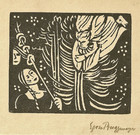Egon Pruggmayer
(1905-1983)
You might say, Egon Pruggmayer wrote the book on German Architecture. The German artist really contributed the images and Art Historian Ludwig Grote, the text, but their collaborative effort produced Deutsche Stilfibel (A German Style Guide), one of the most popular handbooks ever written on German architecture, reprinted in numerous editions, since it was first published in Leipzig in 1936. Pruggmayer had a fine eye for ecclesiastical architecture. The majority of drawings in Deutsche Stilfibel are detailed studies of sacred interiors and exteriors, ranging from early Romanesque chapels of the 8th century to Neo-Gothic churches of the early 19th century.
Pruggmayer belongs to a singular generation of artists who lived through two World Wars and found themselves on the Eastern side of the Iron Curtain in the postwar division of Europe. Born in Dresden, the book illustrator and graphic designer pursued his artistic career in Leipzig. Pruggmayer was a student of Swiss Modernist Paul Klee, and his aesthetic vision was shaped by the Bauhaus movement. In 1946, he joined the faculty of Leipzig’s famous Hochschule fur Grafik und Buchkunst (Academy of Visual Arts), teaching in the book design department.
During the Stalinist era, Pruggmayer ran afoul of East Germany’s Communist regime. His preference for prewar graphic design was considered too “formalist” and “uncontemporary,” at odds with officially sanctioned Social Realist art. Pruggmayer managed to survive the purges at the Leipzig Art Academy in 1951 and found a way to pursue graphic art within the confines of the Communist system. He holds the distinction of making one of the smallest books in the world, Bilder ABC, a miniature art guide published in 1971, measuring only 3 x 2.5 cm.
Pruggmayer not only drew church buildings. He also peopled them in prints with worshippers and angels, as can be seen in three delightful German Expressionist-style woodcuts in the Sacred Art Pilgrim Collection, dating from the 1950s. In The Maiden and the Angel, a fourth piece from the same period, Pruggmayer turns a procession of happy peasants, typical of Social Realist art, into an Annunciation scene. None of these religious subjects endeared him to East Germany’s cultural commissars. Pruggmayer died from Alzheimer’s disease in 1983. His last print, made the same year, depicts jumbled shapes far removed from his once precise architectural drawings. It is titled Meditation.
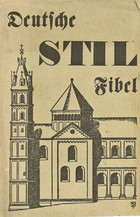
Book Jacket (Deutsche Stilfibel)
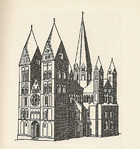
St. George Stiftskirche in Limburg

Interior of Georgskirche in Dinkelsbuhl
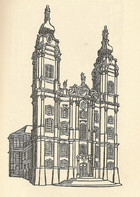
Wallfahrtskiche von Vierzehnheiligen in Bad Staffelstein

Friedrichswerdersche Kirche in Berlin
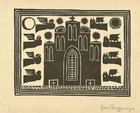
Cathedral Between Night and Day

Nighttime Procession

Angel at the Church Door
